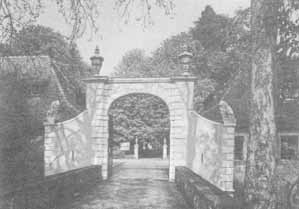Sisters of the Society of St. Pius X
Text by a Sister of the Society of Saint Pius X
Photo Captions by Mary E. Gentges
|
The article and photo story which follow are from the current issue of Crusade,the magazine for young people, published by Saint Mary's College. We, at the Angelus Press, assist in the production of this very fine magazine. We reprint this article for two reasons: 1) it is very interesting and 2) Crusadeis a publication suited to every age group—not simply youngsters. We urge you to subscribe, whether you have a child at home or not. See the advertisement elsewhere in this issue for particulars.
|
OFTEN, WE SISTERS of the Society of St. Pius X hear the question, "What order do you belong to? Where do you come from?" In answer to these questions, we wish to explain for Crusade readers the history of our Order, our life, and our works.
Why a New Religious Order?
Since the days of the Apostles, without interruption, the Church has produced souls consecrated to God through the religious life. Until the end of time, Divine Providence will provide this beautiful fruit of the Church. But, we have seen a decline in religious vocations since Vatican Council II, a decline due in large part to the changes in the Sacrifice of the Mass, and following from that, changes in the spirit of prayer and sacrifice in the religious orders. Recently, however, by the grace of God, some monks and sisters have rebuilt their ancient Orders, so as to continue the pure line of St. Benedict, St. Francis of Assisi, St. Dominic or St. Teresa of Avila.
There is this variety of religious orders in the Church because the Church is an immense garden where every flower has its place and necessity. God sows different vocations in souls, and each must strive to answer his particular call. In addition, in every period of Church history, God has raised up different religious orders or "congregations" suited for the particular needs of the Church at the time.
Gateway to the grounds of the novitiate of the Sisters of the Society of St. Pius X, at St. Michel-en-Brenne, in central France. The property was formerly a large priory; it was acquired by the Society and first used as a retreat house; since 1977 it has become the novitiate for the Sisters. The lovely grounds cover several acres, part of which is put into vegetable gardens.
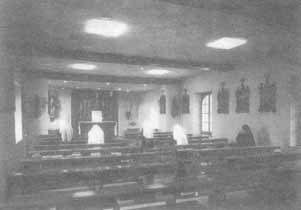
An interior view of the Sisters' chapel at St. Michel-en-Brenne.
Thus, he has permitted the foundation of the Sisters of the Society of St. Pius X—a semi-contemplative Order—to fulfill a need of our times. If ever in the history of the Church there has been a need for consecrated souls to help priests by prayer and sacrifice joined with temporal aid, it is in our troubled days when there is a scarcity of dedicated priests, and these are overwhelmed in their ministry for the salvation of souls.
Remote Beginnings
November, 1970, saw the canonical foundation of the Priestly Society of St. Pius X in Fribourg (Switzerland). The Archbishop, Monseigneur Marcel Lefebvre, who was an important figure in the mission field of the Church, and an eminent defender of the Faith both during and after the last Council, erected a Seminary to train young men to the Priesthood of Our Lord Jesus Christ, to continue the true Sacrifice of the Mass. The Priestly Society is now spread throughout the world and works toward the reconstruction of Christian society through the sanctification of souls.
The priests of the Society have heavy ministry as we see here in the United States. While they work long and fatiguing hours, who will support them with prayers? Who will assume the more humble chores, allowing the priests to give themselves more freely to their priestly duties? Who will take physical care of the chapels, the altar linens, the vestments? Who will teach catechism to the children, giving the truths of the Faith and love for it that will lead them to heaven? To fulfill these needs, a feminine branch of the Society of St. Pius X was founded and now grows in the garden of Holy Church.
The Society of Sisters is Founded
It was in October, 1973, that the first postulant for this new religious congregation arrived at Ecône from Australia. In September, 1974, Monseigneur Lefebvre gave the holy habit to the first Sister of the Society of St. Pius X. The sisters' novitiate was near the Eternal City of Rome for three years, before being transferred in the fall of 1977 to its permanent residence at St. Michel-en-Brenne, a tiny village in the center of France. (Present plans are to open a U. S. novitiate within two years.)
Planted and watered in the beginning by many graces on Roman soil, the Society of Sisters also received a true formation to the religious life due to the great experience of Monseigneur Lefebvre (who was formerly Superior General of the Holy Ghost Fathers). Too, his own sister, Mother Marie Gabriel (who is also from the Holy Ghost Congregation, with fifty-four years of experience in the religious life, of which many years were spent in the missions in Martinique, the West Indies and Africa) guided the Society of Sisters in its initial formation.
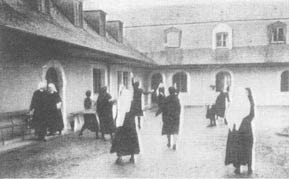
Postulants, novices and professed Sisters, join in a game of ball at recreation time. Postulants are not yet wearing the habit; novices have the white veils; professed sisters wear the black veils. The lower floors of the buildings are used for chapel, study rooms, library, offices, work rooms, sewing room, kitchen and refectory (dining room). Sleeping rooms are upstairs. In one building there are rooms for visitors.
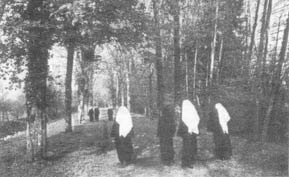
Sisters taking a walk on the beautiful grounds at the novitiate. "The Lord is my shepherd; I shall not want. In verdant pastures He gives me repose; Beside restful waters He leads me; He refreshes my soul."
The Society is developing, and now sees thirty-four professed Sisters in eight houses and four different countries. In May, 1984, Sister Mary Jude, an American Sister who spent almost two years at St. Mary's in Kansas (from 1981 to 1983), became the new Superior General of the Sisters.
A Semi-Contemplative Congregation
The congregation of the Sisters of the Society of St. Pius X is what is called a "semi-contemplative" order. That is, the order observes the "mixed life," a blend of both the active and contemplative lives. While the Sisters are not totally active like a teaching order, neither are they totally cloistered like the Carmelite Order. Our Lord Himself lived the mixed life, preaching and working miracles, then retiring in places of solitude where he could spend many hours in prayer.
Every day the Sisters have an hour of adoration of the Blessed Sacrament, in order to pray for diverse intentions: for the Pope, the bishops, the priests, the consecrated souls, and in particular to make reparation for the outrages committed against Our Lord in the Blessed Sacrament. It is, in fact, the contemplation of Christ on the Cross that makes the true Christian, and gives all its value and grandeur to the religious life.

The Sheepfold—la Bergeneat St. Michel-en-Brenne. The sheep are raised both for the wool and for the meat.
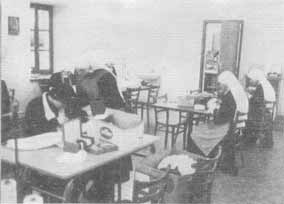
Postulants and novices working in the sewing room at the novitiate. The Sisters mend, make vestments, make altar linens and albs. They make the white surplices worn by the new seminarians who enter the Society seminary at Ecône. It is hard to imagine but this neat sewing room of the Sisters' was converted by them from a former pig barn into this clean-floored work room!
Every true Christian, through Baptism, is a missionary, but by vocation the Sisters are totally dedicated to the Church, working to extend the reign of Christ the King through their own sanctification and through their apostolate. If prayer and spiritual growth are the most important aspects in the life of a baptized soul, they are even more so for a Religious, and especially for a Sister of the Society who is an auxiliary of priests far more by her life of union with Our Lord than by her exterior activities. Her whole life rotates around the Sacrifice of the Mass, source of all graces. Thus, her interior life—and by extension, her apostolic life—flow from the very Sacrifice of Our Lord Jesus Christ. Therefore, the first role of a Sister of the Society is to live as Our Lady lived: united with Christ, cooperating in the Redemption of mankind, and standing at the foot of the Cross interceding for sinners. By her interior life, by her intercession, and by the offering of her daily duties in union with the Sacrifice of Christ, she helps the work of the priest.
Spiritual Formation in the Novitiate
The Church, through lawful superiors, accepts "professions," that is, the total consecration of a soul to God. To be sure that the aspirant truly has a vocation and is suited for the particular religious congregation she has chosen, the Church requires a certain time of preparation before binding vows are taken.
First, a "postulancy" of at least six months is required. During this time, the aspirant turns her back on the maxims of this world, examines her vocation, is formed in the religious life, and is introduced into the life of the Society of St. Pius X. At the end of this period of time, she may ask to receive the habit of the Congregation. (See June/ July, 1984 Crusade for a picture story of the reception of the habit at St. Michel-en-Brenne.)
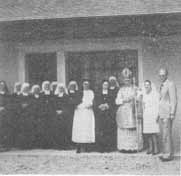
May 1984. Sister Mary Jude, an American Sister, makes her profession as Mother Superior of the Sisters of the Society of St. Pius X. Archbishop Lefebvre received Mother Mary Jude's profession; beside Mother Mary Jude is Mother Marie Gabriel, Archbishop Lefebvre's own sister who guided the initial formation of the order of Sisters and now steps down. Next to the Archbishop are Mother Mary Jude's parents.
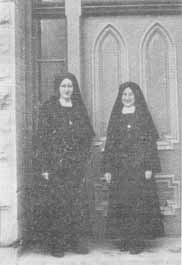
(Opposite)—After the novitiate, professed sisters are given an assignment in one of the houses of the Order. Here, Sister Mary Augustine from France, and Sister Mary Cecelia from Australia, stand in the doorway of Coppens Hall, the building that houses the Upper Girls' School at St. Mary's Academy, St. Marys, Kansas. The large medal that is part of the Sisters' habit shows St. Pius X on the front, and Our Lady of Compassion, Patroness of the Order, on the reverse side.
After reception of the habit begins the novitiate which is the training proper to the religious life. Holy Mother Church requires at least one year of novitiate, and encourages a second year that is devoted to deepening the novice in the spirit of the Congregation.
The life of a novice, and later her life as a professed sister, is a very busy one, exteriorly as well as interiorly. The novice works to deepen the supernatural life and to live it more profoundly each day. She must become a "new creature" as St. Paul says. That is, a soul detached from the things of the earth and oriented toward God so as to accomplish His will and work for His glory. This is a lifetime work requiring constant effort, but it is well-rewarded already in this life and fully in the next.
The novice has daily chores and learns new "trades" to help fulfill the needs of the community and to use in her future apostolate. She learns to sew, to cook, and to garden. But most of all, she must become familiar with her Faith, and with the great truths God has revealed. To this end she has study classes and spiritual conferences.
After two years of novitiate, the novice may then pronounce her first vows of poverty, chastity and obedience. These vows, which are received in the name of the Church, consecrate her totally to God, and make her a true religious. She will renew her vows annually, making final vows after ten years as a professed Sister in the Society of St. Pius X.
Daily Schedule at the Novitiate
For the interest of our readers, we will outline a typical day at the novitiate of the Sisters at St. Michel-en-Brenne.
Rising is at 6:00 a.m., followed by the office of Prime, a half hour of meditation, and Holy Mass. After breakfast there is time for housework. Then each Sister is assigned a particular work—some will go to the sewing room to make vestments or to mend; others will take care of the garden; others will have kitchen or laundry duties; some will be introduced into the secrets of rebinding books or caring for the bees and other animals.
Between 10:00 a.m. and 11:30 a.m., the novice has two classes of study in Catechism, Treaty of the Church, Church History or Holy Scripture. She must possess a solid doctrinal formation so necessary for her future apostolate as well as for her own spiritual balance. These classes—food for her intelligence and for her soul—are followed by half an hour of adoration of the Blessed Sacrament where she unites her soul more closely to the Divine Heart of Our Lord. The midday office of Sext unites all hearts to the prayer of the Church in a hymn of praise so pleasing to God.
Both the noon and evening meals are followed by some time of recreation in which all the Sisters participate with simplicity and joy. After some time in silence in her room, the novice continues her work in the afternoon until Chant practice at 4:30 p.m. where she is initiated into Gregorian Chant and learns to sing Sunday and feastday Masses. At 5:00 p.m. each novice retires to her room to study. She may use the library which includes many doctrinal and spiritual books. A spiritual conference given by the chaplain or the mistress of novices develops the spiritual life. The mistress of novices may explain the Constitutions of the Order and the notions of the religious life that will guide each Sister in her vocation and deepen in her the spirit of the Society. Another half hour of adoration after a conference or spiritual reading is followed by the 6:45 Rosary that is recited daily for benefactors. Then comes the evening meal with a reading during the meal (as at lunch). The day ends with the chant of Compline.

Sister Mary St. Anne with girls at St. Mary's Academy, a twelve-grade Academy for boarding and day students, both boys and girls, an important work of the Sisters is the teaching of religion to lower-school boys and girls, and upper school girls. (Priests teach religion to upper school boys at St. Mary's)
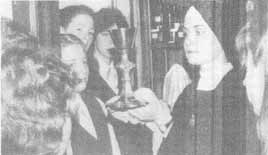
An important work of the Sister is that of sacristan—caring for the altar linens, vestments and vessels. Here, Sister Mary St. Anne gives girls of St. Mary's Academy a tour of the sacristy. Sister is explaining the use of the purificator. Since only men may officiate at the altar, it is a great privilege for a sister to be able to fulfill the office of sacristan, helping to prepare the altar for the Holy Sacrifice of the Mass.
The young girl who enters the religious life is struck at first by two things which she has probably never really experienced in the world: silence and a regulated life.
In order to speak to God, the soul must stop speaking to creatures, and thus silence is rigorous, and sometimes austere, for a beginner in the religious life; but it is indispensable. The novice must learn to converse with God and to perform daily duties in silence which is in no way a hindrance to a happy life in the community. Recreation time is a good proof of the healthy attitudes and familial relationships that exist among the Sisters; another proof of this relationship is their cheerful talk as they take walks together.
Secondly, she experiences a regulated life: a bell announces the beginning and end of each spiritual exercise, practice, or work—time to get up, time to sleep, time to pray, time to eat. The bell is there to remind the religious that God is calling her to another duty, that her time is given to Him, and that all things are ruled by holy obedience.
After the Novitiate
The novice, once professed, leaves the novitiate, the cradle of her religious life, often with a heavy but yet a happy heart: the memories of childhood are always the best ones. But she is attached to her religious family by strong ties, and will always find the same spirit in any of the houses to which she may be sent. She will always carry with her and continue to develop the two characteristics that are specifically the Society's: a luminous and deep faith, allied to the virtue of simplicity.
Depending on the language she speaks (there are presently seven nationalities among the Sisters), her aptitudes, and the needs of the Congregation, she may be sent to any one of the houses in France, Belgium, Switzerland, the United States, or any other future foundations. The communities are of three to five members and generally will remain that size.
Once arrived at her new community, she will find what she has left at the novitiate: the Blessed Sacrament, silence, time given to prayer and spiritual reading, a monthly day of recollection, and the same or very slightly changed daily schedule according to the apostolate. She will also find the same joy and family life.
In her new assignment she may be asked to teach catechism in a grade school, for the most important exterior apostolate is the teaching of the Catechism. A Society Sister has a special mission to inculcate the Faith in the hearts of the young. She may do the work of a sacristan, or be called on to take care of the material needs of the priests so that they may have more time for their ministry to souls. She may also visit the sick or elderly people, and prepare them for the visit of the priest when necessary.
Whatever a Sister does, all her work will be motivated by a love of God and the desire to save souls. "Nothing will be small or insignificant in her life; all things will be a grace and will sanctify her." She will try to complete the apostolate of the priest by her spirit of prayer and sacrifice, happy to live in full her religious vocation and as a consecrated soul, a spouse of Christ, and a spiritual mother in the Church and in the Society of St. Pius X.
+ + +
|
Girls who are interested in joining the Sisters of the Society of Saint Pius X may contact Sister Mary Augustine at St. Mary's College. Visits to St. Mary's, lasting several days, can be arranged in order for young ladies to observe the life of the Sisters and learn more about the Order. Write: |
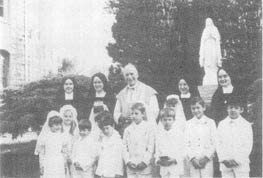
Each year the Sisters prepare the little ones of St. Mary's for their first Confession and First Holy Communion. Here is the 1984 class with His Grace Archbishop Lefebvre and the Sisters.
